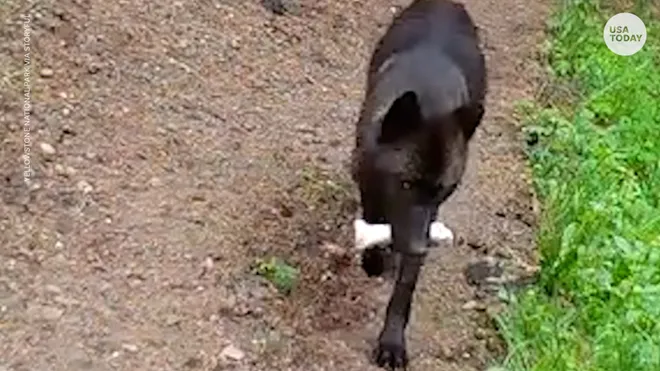Watch Yellowstone wolves bring 'toys' home to their teething pups
We’ve all heard the adage about our snuggly pet dogs still being “wolves at heart.” While it can be easy to forget when watching our spoiled pooches enjoy fluffy beds, they are descendants of the adept hunters we still see in the wild today.
An adorable post shared by Yellowstone National Park, however, is a reminder that our canines still have more in common with their ancestors than we give them credit for.
The video, shared to the national park’s Facebook page Tuesday, was recorded by Yellowstone biologists in spring of this year. In the video, gray wolves can be seen trotting back to their dens with gifts in-mouth.
While eager pups usually expect a meal delivery when adults return to the den with something in tow, they also accept a treat any parent knows will cheer a little one up: toys.
While gray wolves living in the national park don’t exactly have access to squeaky balls and pull ropes, they still enjoy something to chew on, said the national park’s post. Instead of returning home empty-handed when a hunt is unsuccessful, adult wolves can be seen in video clips returning with antlers, animal bones and sticks, presumably to serve as teething remedies for bite-y puppies.
“The instinct to bring items back to the den may be reinforced by evolution, and probably helps keep adults from being mobbed by sharp puppy teeth,” said Yellowstone National Park in the post.
In a series of clips, adults belonging to a group called “Mollie’s Pack” can be seen strutting past wildlife cameras with “toys” of various sizes between their teeth. The videos were compiled throughout the spring, as litters are generally born mid-April. By late October, the pups begin traveling with the pack and learning to hunt.

Gray wolves in Yellowstone
According to the Yellowstone National Park website, the northern Rocky Mountain wolf (Canis lupus) was classified as an endangered species in 1972 and the Greater Yellowstone Ecosystem was soon designated as a recovery area.
Wolves were released into the GYE in the 1990s where they were protected from human infringement and allowed to repopulate. The park celebrated the 25th anniversary of wolves turning to Yellowstone in January of 2020.
Since 2009, the population has fluctuated between 83 and 123 wolves; as of January this year, there were at least 108 wolves in the park spread across 10 packs.
The wolves generally mate in February and give birth to an average of four to five pups in April. Litters are weaned from milk when they reach five to nine weeks old, at which point adult wolves begin bringing them food from hunts for another three months.
While not all pups survive through their first winter, wolves within the GYE generally enjoy a longer lifespan of four to five years as opposed to two to three years outside of protected land.
Disclaimer: The copyright of this article belongs to the original author. Reposting this article is solely for the purpose of information dissemination and does not constitute any investment advice. If there is any infringement, please contact us immediately. We will make corrections or deletions as necessary. Thank you.






